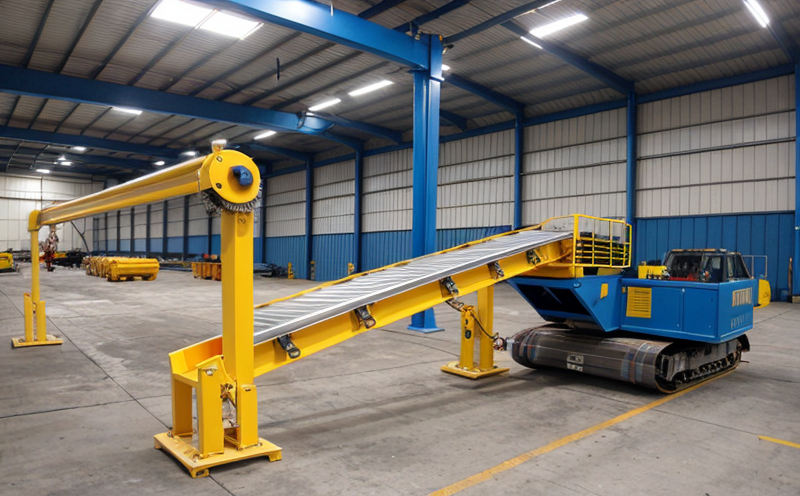ASTM D5963 Abrasion Resistance of Conveyor Belt Compounds Testing
The ASTM D5963 standard test method is a critical tool in evaluating the abrasion resistance properties of conveyor belt compounds used in mining and other heavy-duty industries. This test is essential for ensuring that conveyor belts can withstand continuous abrasive wear, which is a major cause of belt failure leading to downtime and increased maintenance costs.
The abrasion resistance of conveyor belts is measured by subjecting the compound to repeated frictional action with an abrasive wheel. The rate at which the surface of the belt wears away is then quantified, providing valuable insights into the durability and longevity of the belt material. This test plays a crucial role in quality assurance and product development, ensuring that materials meet or exceed industry standards.
The abrasion resistance testing aligns with broader efforts to enhance safety and efficiency within mining operations. Conveyor belts are vital components in the transportation of raw materials like coal, minerals, and ore. Ensuring their robustness is not only a matter of operational continuity but also contributes to environmental sustainability by minimizing waste and resource consumption.
The test procedure involves mounting a belt sample on a rotating wheel that simulates real-world conditions. The abrasive wheel rotates against the belt at a specified speed and pressure, creating frictional wear. The amount of material removed from the surface is measured using calibrated instruments. This measurement provides a direct indicator of the abrasion resistance properties of the compound.
The test results are reported in milligrams per meter (mg/m) or grams per square foot (g/ft²), depending on the units used by the industry standard being followed. These metrics help manufacturers and users assess the performance of different materials and make informed decisions about material selection, design optimization, and quality control.
ASTM D5963 is widely recognized in the mining sector for its relevance to conveyor belt testing. The test method ensures that the materials used are suitable for high-wear applications, thereby enhancing operational reliability and reducing maintenance costs. By adhering to this standard, industries can demonstrate compliance with international quality standards, which is crucial for maintaining a competitive edge in global markets.
Understanding the abrasion resistance of conveyor belt compounds is essential for optimizing material performance and extending service life. This testing provides critical data that helps in selecting materials that not only meet but exceed industry expectations. The insights gained from this test can be instrumental in improving product design, enhancing manufacturing processes, and ensuring consistent quality.
- Robustness: Ensures belts can withstand harsh environments and continuous use.
- Durability: Helps in selecting materials that extend the lifespan of conveyor systems.
- Efficiency: Reduces downtime and maintenance costs, contributing to overall operational efficiency.
In conclusion, ASTM D5963 abrasion resistance testing is a cornerstone for ensuring the reliability and longevity of conveyor belt compounds in mining operations. By adhering to this standard, industries can enhance safety, optimize performance, and maintain compliance with international quality standards.
Scope and Methodology
The scope of ASTM D5963 focuses on evaluating the abrasion resistance properties of conveyor belt compounds. This test is particularly relevant for materials used in mining operations where continuous wear from abrasive surfaces can significantly impact performance and safety.
The methodology involves mounting a sample of the conveyor belt compound onto a rotating wheel, which simulates real-world conditions. The abrasive wheel rotates at a specified speed and pressure against the sample, creating frictional wear. The amount of material removed from the surface is measured using calibrated instruments. This measurement provides a direct indicator of the abrasion resistance properties of the compound.
The test procedure is standardized to ensure consistency in results across different laboratories and industries. It involves specific parameters such as belt width, rotational speed, pressure, and duration of testing. These parameters are carefully controlled to simulate real-world conditions accurately. The results are reported in milligrams per meter (mg/m) or grams per square foot (g/ft²), depending on the units used by the industry standard being followed.
The methodology also includes detailed instructions for preparing the test samples, mounting them onto the testing apparatus, and operating the equipment. These steps ensure that the results are reliable and reproducible. Compliance with these procedures is critical to obtaining accurate and meaningful data.
ASTM D5963 is designed to be flexible enough to accommodate various types of conveyor belt compounds. This allows for a comprehensive evaluation of different materials, ensuring that they meet or exceed industry standards. The test results are widely recognized as a reliable indicator of the abrasion resistance properties of conveyor belt compounds.
Why Choose This Test
- Enhanced Reliability: Ensures that conveyor belts can withstand harsh environments and continuous use, reducing the risk of failure.
- Cost Efficiency: By selecting materials with excellent abrasion resistance, industries can minimize maintenance costs and downtime.
- Safety Assurance: Robust conveyor belts contribute to safer operations by minimizing accidents and injuries associated with belt failures.
- Performance Optimization: The test provides valuable insights into the performance of different materials, enabling manufacturers to optimize their products.
- Compliance Assurance: Ensures that materials meet or exceed industry standards, facilitating compliance with international regulations.
- Quality Control: Provides a reliable method for quality control, ensuring consistent product quality and customer satisfaction.
- Competitive Edge: Demonstrates commitment to excellence in product design and manufacturing, enhancing the competitive position of industries.
In summary, choosing ASTM D5963 abrasion resistance testing is a strategic decision that enhances reliability, efficiency, safety, and performance. It provides essential data for making informed material selection decisions, optimizing product designs, and ensuring compliance with international standards.





